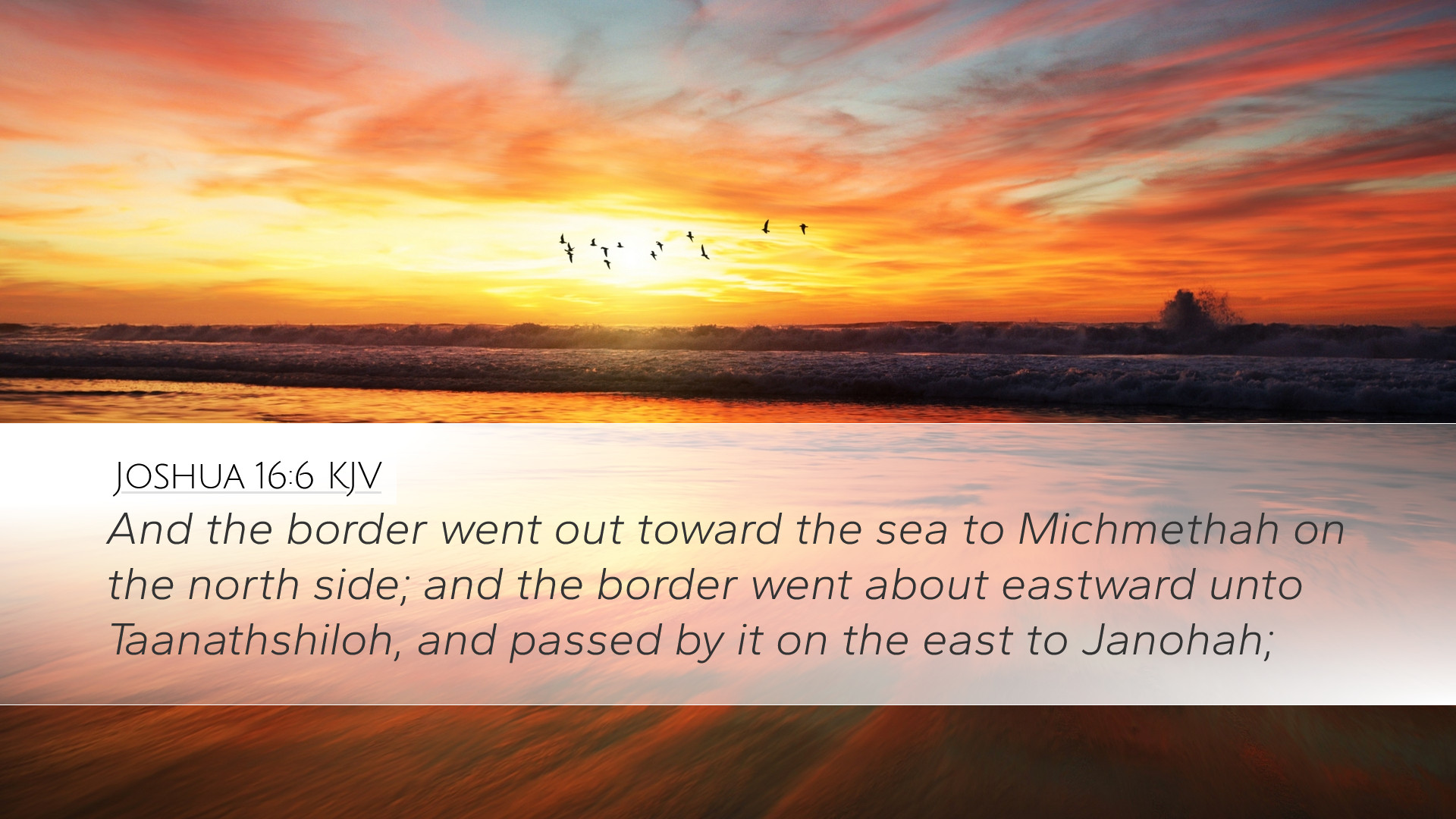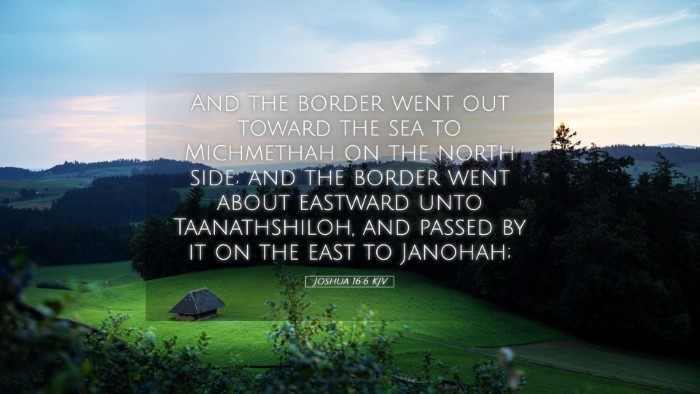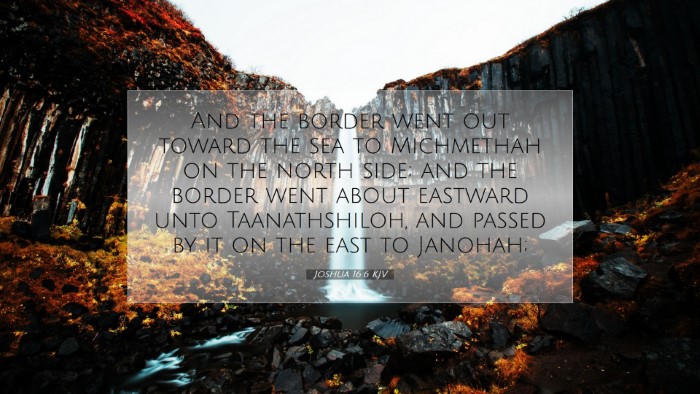Old Testament
Genesis Exodus Leviticus Numbers Deuteronomy Joshua Judges Ruth 1 Samuel 2 Samuel 1 Kings 2 Kings 1 Chronicles 2 Chronicles Ezra Nehemiah Esther Job Psalms Proverbs Ecclesiastes Song of Solomon Isaiah Jeremiah Lamentations Ezekiel Daniel Hosea Joel Amos Obadiah Jonah Micah Nahum Habakkuk Zephaniah Haggai Zechariah MalachiJoshua 16:6
Joshua 16:6 KJV
And the border went out toward the sea to Michmethah on the north side; and the border went about eastward unto Taanathshiloh, and passed by it on the east to Janohah;
Joshua 16:6 Bible Commentary
Commentary on Joshua 16:6
Bible Verse: "And the border went out toward the sea to Michmethah on the north side; and the border went around eastward unto Taanathshilo, and passed by it on the east to Janohah."
Introduction
The verse from Joshua 16:6 is part of the delineation of the boundaries of the tribe of Ephraim. This geographical description is essential for understanding the division of land among the tribes of Israel during the conquest of Canaan. Commentaries by Matthew Henry, Albert Barnes, and Adam Clarke provide rich insights into the historical and theological significance of this passage.
Boundary Descriptions
In this verse, we see the specific mention of geographical locations which form the boundary of the territory assigned to the tribe of Ephraim. The mention of places such as Michmethah, Taanathshilo, and Janohah is important as it not only marks the land but also shows God’s faithfulness in fulfilling His promise to Abraham, Isaac, and Jacob regarding the land for their descendants.
Significance of Michmethah
Matthew Henry notes that Michmethah likely served as a key point on the border, representing the northwestern edge of Ephraim’s territory. This further symbolizes the idea of taking possession of the land God promised to His people. The name Michmethah may derive from a Hebrew root meaning “to divide” or “to measure” which can also symbolize God’s precise dealings with His people.
Taanathshilo's Role
Albert Barnes emphasizes Taanathshilo's significance as an area that would contribute to the cultural and religious life of the tribe. The proximity of this location to Shiloh, where the Tabernacle was set, indicates its importance in gathering for worship and sacrifice, showcasing the tribe’s identity centered around worship and community.
Janohah's Implications
Adam Clarke interprets Janohah as possibly signifying a place of “consolation” or “comfort.” This underscores the idea that the lands allotted to the Israelites were not just territories but places meant for the flourishing of God’s people, where they could find peace and rest in covenant relationship with Him. The selection of these boundary markers conveys the thought that God provided lands for both physical sustenance and spiritual flourishing.
Theological Themes
This verse, while seemingly a mere geographical account, encapsulates profound theological themes that resonate throughout Scripture.
God’s Faithfulness
The establishment of borders as stated in Joshua 16:6 reflects God’s unwavering faithfulness to His covenant promises. Each boundary signifies a promise fulfilled, echoing the theme prevalent throughout the Old Testament. Henry highlights that this faithfulness reassures believers of God’s sovereignty and the certainty of His promises.
Divine Order and Authority
As boundaries are defined, we see an order that God has instituted among His people. Barnes points out that such organization speaks to the divine authority in establishing not only spiritual but also social order within the community of Israel. The way land was distributed is reflective of God’s just character.
Community Identity
The delineation of tribal boundaries contributed to the identity of the Israelites as a chosen nation, called to be different from the nations around them. Clarke elaborates on this by noting that having defined territories enabled the tribes to develop their unique customs and practices centered around their covenant relationship with Yahweh.
Practical Applications
From this study, several practical applications can be drawn for pastors, theologians, and students of the Bible:
- Stewardship of God’s Promises: Just as the Israelites were to take possession of their land, modern believers are called to recognize and claim the promises of God for their lives.
- Understanding Identity in Community: The church can learn from the boundaries given to the tribes that define and separate God’s people for His purposes. This can lead to a deeper understanding of community and identity within the body of Christ.
- Appreciation for Divine Order: The systematic distribution of land serves as a reminder of God’s orderly nature which can be an encouragement for believers to seek God’s order in their own lives and ministries.
Conclusion
Joshua 16:6 may appear as a logistical account of land boundaries, but it encapsulates richer themes of God’s faithfulness, divine authority, and community identity. By understanding the depths of this verse through the lens of public domain commentaries, believers are encouraged to grasp the significance of God’s promises and the importance of their role within His Kingdom.


